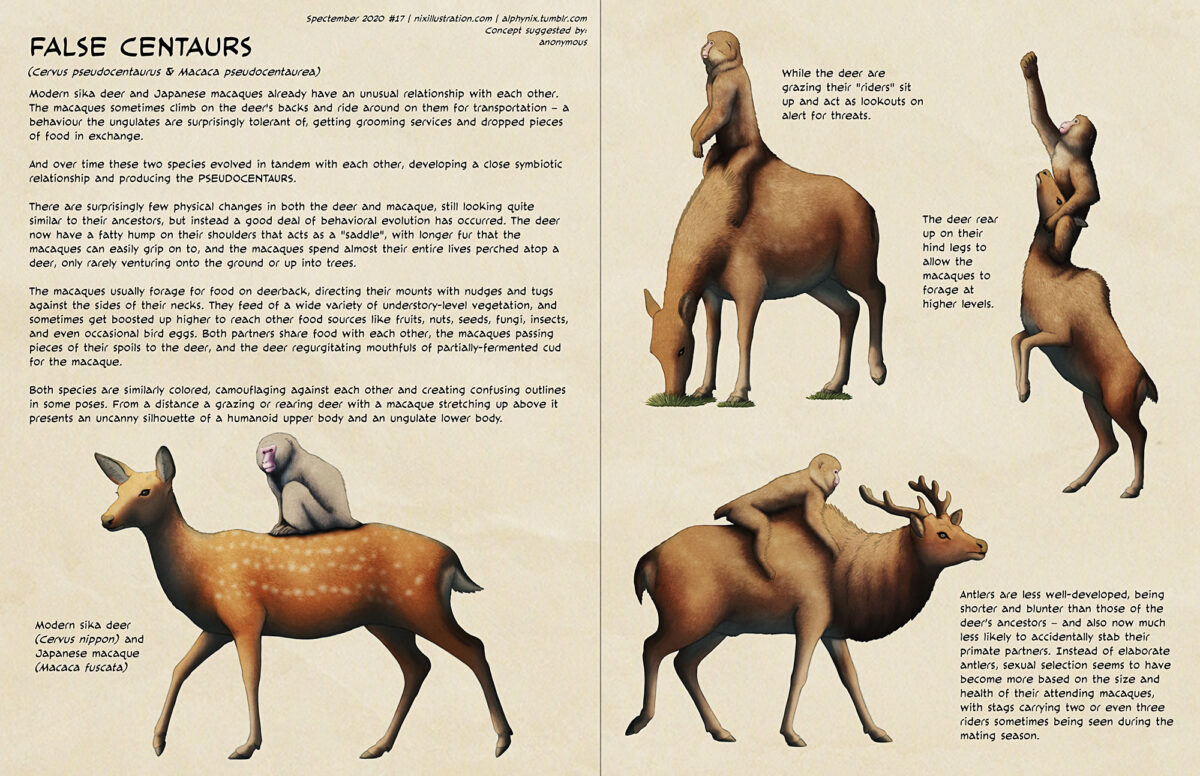Transcript for the text on the image under the cut:
PAGE 1
Spectember 2020 #17 | nixillustration.com | alphynix.tumblr.com
Concept suggested by:
anonymous
False Centaurs
(Cervus pseudocentaurus & Macaca pseudocentaurea)
Modern sika deer and Japanese macaques already have an unusual relationship with each other. The macaques sometimes climb on the deer’s backs and ride around on them for transportation – a behaviour the ungulates are surprisingly tolerant of, getting grooming services and dropped pieces of food in exchange.
And over time these two species evolved in tandem with each other, developing a close symbiotic relationship and producing the PSEUDOCENTAURS.
There are surprisingly few physical changes in both the deer and macaque, still looking quite similar to their ancestors, but instead a good deal of behavioral evolution has occurred. The deer now have a fatty hump on their shoulders that acts as a “saddle”, with longer fur that the macaques can easily grip on to, and the macaques spend almost their entire lives perched atop a deer, only rarely venturing onto the ground or up into trees.
The macaques usually forage for food on deerback, directing their mounts with nudges and tugs against the sides of their necks. They feed of a wide variety of understory-level vegetation, and sometimes get boosted up to reach higher food sources like fruits, nuts, and even occasional bird eggs. Both partners share food with each other, the macaques passing pieces of their spoils to the deer, and the deer regurgitating mouthfuls of partially-fermented cud for the macaque.
Both species are similarly colored, camouflaging against each other and creating confusing outlines in some poses. From a distance a grazing or rearing deer with a macaque stretching up above it presents an uncanny silhouette of a humanoid upper body and an ungulate lower body.
[Image: a furry short-tailed monkey riding on the back of a deer.]
Modern sika deer (Cervus nippon) and Japanese macaque (Macaca fuscata)
PAGE 2
[Image: a monkey standing up alert on the large shoulder hump of a casually grazing deer. They’re both similarly-colored and the monkey’s legs are partially obscured by long mane-like fur, almost looking like it’s physically growing out of the deer’s back.]
While the deer are grazing their “riders” sit up and act as lookouts on alert for threats.
[Image: a deer rearing on its hind legs and stretching upwards. A monkey is clinging to the back of its head, being boosted up to reach towards something. Their forms similarly appear to blend together, creating a silhouette resembling a centaur.]
The deer rear up on their hind legs to allow the macaques to forage at higher levels.
[Image: a deer with slightly stubby blunt antlers walking along, a monkey laying on its back.]
Antlers are less well-developed, being shorter and blunter than those of the deer’s ancestors – and also now much less likely to accidentally stab their primate partners. Instead of elaborate antlers, sexual selection seems to have become more based on the size and health of their attending macaques, with stags carrying two or even three riders sometimes being seen during the mating season.

